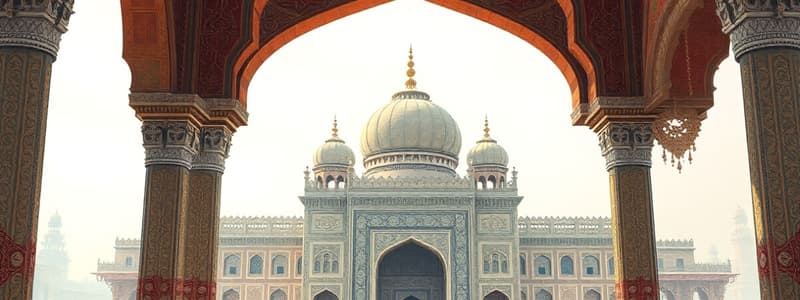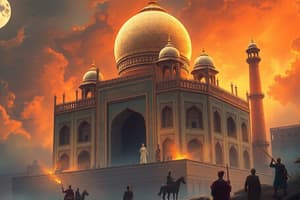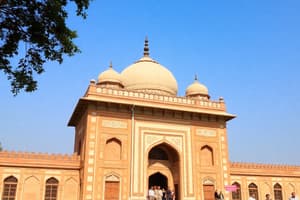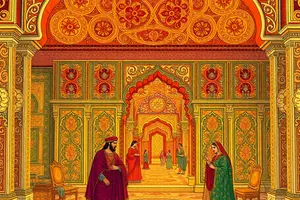Podcast
Questions and Answers
The decline of the Mughal Empire was hastened by the death of ______.
The decline of the Mughal Empire was hastened by the death of ______.
Aurangzeb
Aurangzeb's policies of religious intolerance made him enemies among regional groups like the ______.
Aurangzeb's policies of religious intolerance made him enemies among regional groups like the ______.
Rajputs
The Mughal Empire was weakened due to wars that emptied the ______.
The Mughal Empire was weakened due to wars that emptied the ______.
treasury
The rulers who succeeded Aurangzeb were often described as ______ and lazy.
The rulers who succeeded Aurangzeb were often described as ______ and lazy.
After Aurangzeb's death, a war of ______ broke out among his sons.
After Aurangzeb's death, a war of ______ broke out among his sons.
Bahadur Shah, who won the war of succession, became emperor but was already ______ years old.
Bahadur Shah, who won the war of succession, became emperor but was already ______ years old.
The military strength of the Mughal Empire relied on the ______ and mansabdari systems.
The military strength of the Mughal Empire relied on the ______ and mansabdari systems.
The Mughal court became dominated by ______ in the absence of strong rulers.
The Mughal court became dominated by ______ in the absence of strong rulers.
Chikka Krishna Raj created the independent kingdom of ______ in the beginning of the 18th century.
Chikka Krishna Raj created the independent kingdom of ______ in the beginning of the 18th century.
Hyder Ali established a powerful and modern ______.
Hyder Ali established a powerful and modern ______.
Tipu Sultan succeeded Hyder Ali in ______.
Tipu Sultan succeeded Hyder Ali in ______.
The Maratha kingdom was the strongest of the new kingdoms that grew out of the decline of the ______ Empire.
The Maratha kingdom was the strongest of the new kingdoms that grew out of the decline of the ______ Empire.
Chhatrapati ______ Maharaj was inspired by his spiritual guide, Guru Randas.
Chhatrapati ______ Maharaj was inspired by his spiritual guide, Guru Randas.
Shivaji began his conquests from the age of ______.
Shivaji began his conquests from the age of ______.
Under the second peshwa, ______ Rao I, the Marathas became very powerful.
Under the second peshwa, ______ Rao I, the Marathas became very powerful.
The Marathas signed a treaty with the Mughal emperor in ______ during the reign of Peshwa Balaji Baji Rao.
The Marathas signed a treaty with the Mughal emperor in ______ during the reign of Peshwa Balaji Baji Rao.
The Third Battle of ______ was a significant defeat for the Marathas in 1761.
The Third Battle of ______ was a significant defeat for the Marathas in 1761.
Shivaji and his son escaped from prison in ______ with a clever plan involving baskets of sweets.
Shivaji and his son escaped from prison in ______ with a clever plan involving baskets of sweets.
The Mughal Empire began to collapse under the negligence of the later ______.
The Mughal Empire began to collapse under the negligence of the later ______.
Nadir Shah, the ruler of ______, invaded India in 1739.
Nadir Shah, the ruler of ______, invaded India in 1739.
Ahmad Shah Abdali invaded India several times and dealt a deathblow to the already crumbling Mughal ______.
Ahmad Shah Abdali invaded India several times and dealt a deathblow to the already crumbling Mughal ______.
The jagirdari and mansabdari systems were military systems designed by ______.
The jagirdari and mansabdari systems were military systems designed by ______.
A holder of a jagir was known as a ______.
A holder of a jagir was known as a ______.
Muhammad Shah appointed Chin Qilich Khan as the governor of ______ in 1722.
Muhammad Shah appointed Chin Qilich Khan as the governor of ______ in 1722.
Saadat Khan established a semi-independent province in ______.
Saadat Khan established a semi-independent province in ______.
Murshid Quli Khan was the governor of ______ who added Bihar and Orissa to his territory.
Murshid Quli Khan was the governor of ______ who added Bihar and Orissa to his territory.
The Sikhs began fighting against the Mughals under the guidance of their tenth guru, ______.
The Sikhs began fighting against the Mughals under the guidance of their tenth guru, ______.
Raja Sawai Jai Singh founded the city of ______.
Raja Sawai Jai Singh founded the city of ______.
The Rohillas carved the kingdom of ______ out of Moradabad, Bijnor, and Bareilly.
The Rohillas carved the kingdom of ______ out of Moradabad, Bijnor, and Bareilly.
Maharaja Sawai Singh built astronomical observatories known as ______ Mantar.
Maharaja Sawai Singh built astronomical observatories known as ______ Mantar.
The British defeated Sirajuddaulah in the Battle of ______ in 1757.
The British defeated Sirajuddaulah in the Battle of ______ in 1757.
Aurangzeb appointed Zulfikar Ali as the nawab of the ______.
Aurangzeb appointed Zulfikar Ali as the nawab of the ______.
Ali Khan Wallajah became independent of the Mughals in ______.
Ali Khan Wallajah became independent of the Mughals in ______.
Flashcards
Who was Aurangzeb?
Who was Aurangzeb?
Last major Mughal emperor; his death in 1707 marked the beginning of the empire's decline.
What are Jagirdari and Mansabdari?
What are Jagirdari and Mansabdari?
System of land assignments and ranks that weakened due to neglect after Akbar's rule.
Who was Nadir Shah?
Who was Nadir Shah?
Persian ruler who invaded India in 1739, dealing a major blow to the already weakened Mughal Empire.
What was Third Battle of Panipat?
What was Third Battle of Panipat?
Signup and view all the flashcards
What is Hyderabad?
What is Hyderabad?
Signup and view all the flashcards
What is Awadh?
What is Awadh?
Signup and view all the flashcards
What is Bengal?
What is Bengal?
Signup and view all the flashcards
What is Punjab under Ranjit Singh?
What is Punjab under Ranjit Singh?
Signup and view all the flashcards
Who was Shivaji Maharaj?
Who was Shivaji Maharaj?
Signup and view all the flashcards
Who were the Peshwas?
Who were the Peshwas?
Signup and view all the flashcards
What was the Third Battle of Panipat?
What was the Third Battle of Panipat?
Signup and view all the flashcards
Who was Maharaja Sawai Singh?
Who was Maharaja Sawai Singh?
Signup and view all the flashcards
Who were Hyder Ali and Tipu Sultan?
Who were Hyder Ali and Tipu Sultan?
Signup and view all the flashcards
Study Notes
Decline of the Mughal Empire
- The Mughal Empire weakened significantly post-Aurangzeb's death in 1707.
- Aurangzeb's lack of political skill and reversal of religious tolerance alienated regional powers like the Rajputs, Marathas, and Sikhs.
- Continuous military campaigns drained the treasury, leading to army demoralization due to delayed payments.
- Successors to Aurangzeb exhibited incompetence, squandering wealth and exacerbating court conflicts over succession.
- Key rulers included Aurangzeb, Bahadur Shah, Jahandar Shah, Farrukhsiyar, Muhammad Shah, and Bahadur Shah Zafar (last Mughal emperor).
Military and External Challenges
- The jagirdari and mansabdari systems, developed by Akbar, faltered under neglect.
- Mughal military was inferior compared to foreign invaders, resulting in vulnerability.
- Nadir Shah of Persia invaded in 1739, causing significant loss and weaken the empire's grip on India.
- The Third Battle of Panipat in 1761 saw Ahmad Shah Abdali defeat the Marathas, further destabilizing the Mughals.
- European powers exploited internal disarray in India to establish control.
Emergence of Independent Regional States
- Fragmentation led to the rise of regional kingdoms, including Hyderabad, Awadh, Bengal, Punjab, and various Rajput states.
Regional Kingdom Highlights
- Hyderabad: Established by Nizam-ul-Mulk in 1724, known for art and culture while remaining nominally loyal to the Mughals.
- Awadh: Governed by Saadat Khan; notable for Urdu poetry and music; fell to British control post-Battle of Buxar in 1764.
- Bengal: Under Murshid Quli Khan's leadership, saw prosperity and was first targeted by British forces after the Battle of Plassey in 1757.
- Punjab: Sikhs, initially opposed to Mughal rule, established a powerful Sikh empire under Ranjit Singh in the 18th century.
Notable Figures and Events
- Shivaji Maharaj: Maratha leader born in 1627, emphasized swaraj (freedom); expanded territory significantly before his death in 1680.
- Peshwas: Balaji Vishwanath and his successors became dominant figures in Maratha governance, especially under Baji Rao I.
- Third Battle of Panipat (1761): Decisive defeat for the Marathas against Ahmad Shah Abdali, leading to British ascendancy in India.
Cultural Contributions
- Maharaja Sawai Singh: Promoted science through Jantar Mantar observatories; significant contributions to astronomy and geometry remain influential today.
- Hyder Ali and Tipu Sultan: Established the Mysore Kingdom, expanding military power and defense against British forces.
Conclusion
- The 18th century in India marked a transition from Mughal dominance to regional powers establishing semi-independent states, paving the way for eventual British colonial rule.
Studying That Suits You
Use AI to generate personalized quizzes and flashcards to suit your learning preferences.




